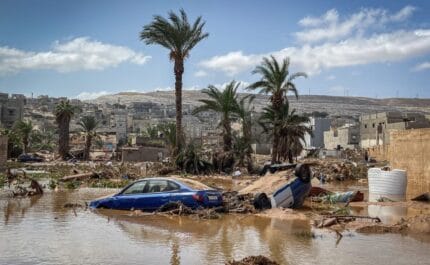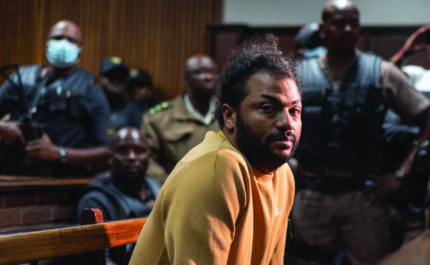Striking oil could transform Guyana – but for better or worse?
On 5th August 2016 ExxonMobil officially started Guyana’s oil boom by applying for permission to begin production off the country’s coast. The resulting revenues could transform Guyana from one of the poorest nations in South America to one of the richest – but corruption and crime loom large. Susan Schulman visited a nation waiting in hope
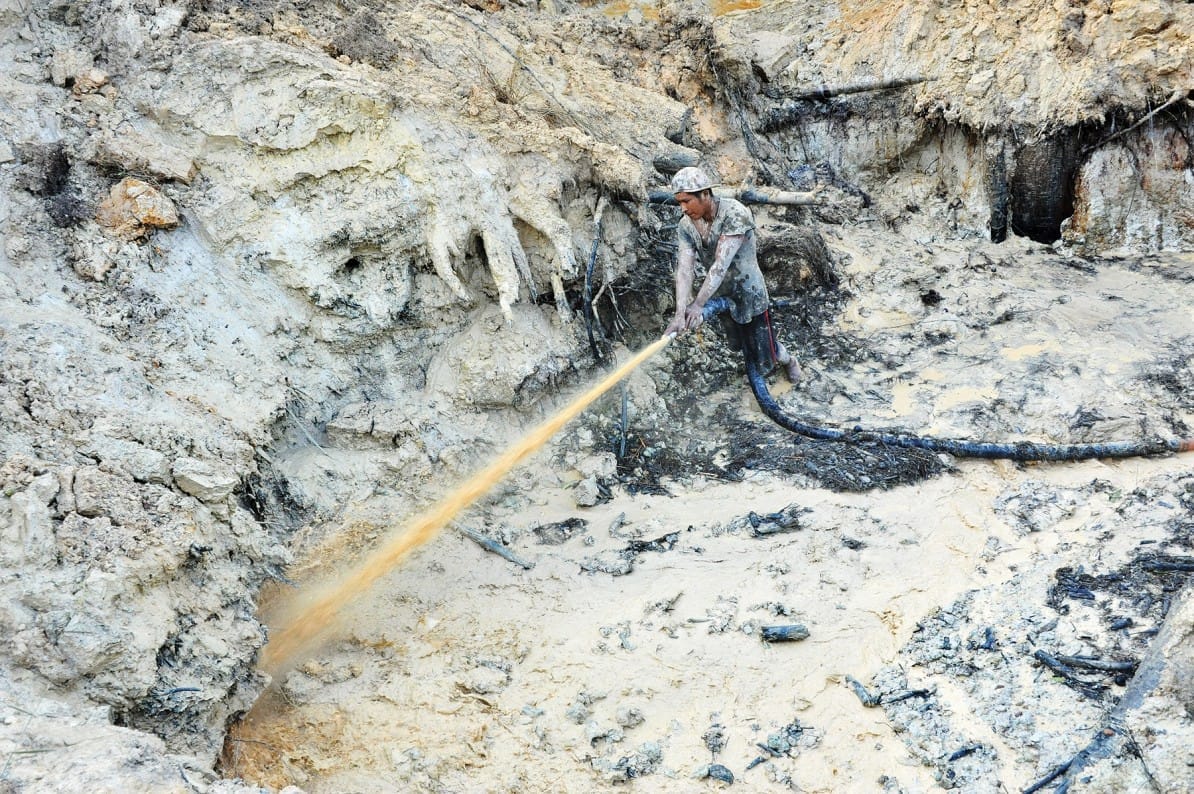
A prospector blasts the rockface in one of Guyana’s remote gold mining outposts. Photo: Susan Schulman
5th August 2016 (Taken from: #24)
It’s easy to get a gun here in Georgetown, the capital city of Guyana. You can even rent one – a “hammer” in the local street jargon – without having to lay out any cash upfront. Terms are accommodating: payment is due afterwards and is based on the take from your crime. The going rate is between two and three percent.
“Many days you have nothing to eat and you take the easy way – the illegal way,” explains Laurice, 40, tossing his waist-long dreadlocks over his shoulder. We are sitting with a group of his friends in West Ruimveldt, a low-rise neighbourhood near the Demerara river. “You might start with petty crime and step up to major,” he says. “Then you get someone stand in your way and you kill them.”
The streets are lined with dilapidated two-storey wooden houses. Gangs of kids hang out on porches and in alleyways. One boy covers his head with a blue patterned bandana as he sees me coming; another slinks inside, burying his face in the crook of his arm. No one wants their photo taken.
There is almost no work here: youth unemployment in Guyana sits stubbornly at 40 percent, and GDP is a mere US $4,127 per capita. According to the latest available figures 36 percent of the Guyanese fall below the poverty line, half of whom are classified as “extremely” poor. “The only jobs [the young] have they are creating for themselves – selling drugs and arms,” says Laurice’s friend Sharon. “And they are very creative at it!”
Each day, local newspapers are emblazoned with grisly headlines of murders and violent robberies, and the levels of crime are rocketing. The US state department’s bureau of diplomatic security says that Guyana’s murder rate has increased from three times that of the United States to four times in the last year.
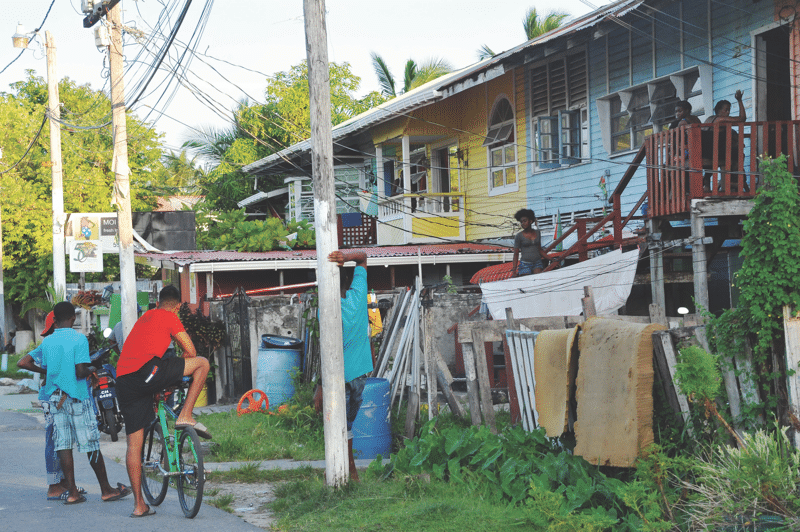
Poverty and violent crime are part of daily life in West Ruimveldt, Georgetown. Photo: Susan Schulman
Brain drain is severe: 55 percent of Guyanese and 85 percent of those with a tertiary level of education live abroad. Perhaps most grimly in the roster of failed-state statistics, Guyana has the highest suicide rate in the world. It’s a cruel daily reality for a country which is still best known internationally for the Jonestown massacre, a mass suicide of 918 members of Jim Jones’s People’s Temple cult deep in the jungles of northern Guyana in 1978.
Guyana finds itself on the threshold of a windfall, poised to become the newest member in the exclusive club of global oil superpowers”
Yet despite the apparent bleakness of its outlook, Guyana is suddenly generating great excitement in boardrooms across the world – and may be on the brink of a major change in fortune. After decades of fruitless searching, the country has struck oil in its territorial waters.
A lot of it. The finds have hit 1.4 billion barrels so far – worth more than $60 billion based on the current oil price – and that is only the beginning. The offshore discovery is one of the biggest finds anywhere in the world in recent memory. It is being described as “game-changing” in the oil and gas sector and ExxonMobil, the world’s biggest oil company, has started to pour in investment. As major expectations set the oil world abuzz, Guyana finds itself on the threshold of a windfall, poised to become the newest member in the exclusive club of global oil superpowers.
Guyana is sandwiched between Venezuela and Suriname on the northeast Atlantic coast of South America. It’s an English-speaking country with a Caribbean vibe and it feels very different from its continental neighbours, a legacy of its unique history. Guyana became Britain’s only colony in South America in 1814 and remained so until the country achieved independence in 1966.
Its population is a mixture of Afro-Guyanese descendants of slaves, Indo-Guyanese – who were brought over from India by the British as indentured labourers to work in the sugar plantations after the abolition of slavery throughout the empire in the 1830s – and indigenous Amerindians. The Afro-Guyanese and Indo-Guyanese communities are traditionally rival groups, each represented by their own political parties, and long-term ethnic tensions have consistently undermined stability and progress in the country.
There are tensions with other countries too. Neither of Guyana’s Atlantic neighbours accept the legitimacy of its borders. Both Venezuela and Suriname have laid claim to substantial areas of the country – including the area off whose coast the oil has been found.
Guyana has historically been dependent on sugar, rice and gold. The removal of government subsidies on sugar production has made it unviable in the international market and in recent years unpredictable rainfall – attributed to climate change – has started to adversely affect rice production. The price of gold has been in a steady decline, losing 25 percent of its value over the past five years. “Gold is the only thing keeping the economy going,” says former auditor general and advocate for good governance Anand Goolsarran. “If there is a further dip in the gold price, we will be in big trouble,” he warns. Even when the gold price is strong, between 50 and 60 percent of the country’s production is lost to smuggling and corruption.
The precariousness of the economy makes the oil find all the more important – and exciting.
I am hoping it will bring a better standard of life, more jobs. And it’s given people a lift… It’s given people hope”
Conservative unofficial estimates, based only on what has been discovered thus far at today’s low price ($45 per barrel at time of going to press), anticipate that the first stage of production alone will bring US $230 million a year in tax receipts to Guyana’s government, nearly a third of the nation’s current annual budget. But the sum is a mere fraction of the US $5.5 billion per year that is ultimately expected to fill the country’s coffers, based on a revenue-sharing deal agreed with ExxonMobil in 1999. The oil provides an extraordinary opportunity to take Guyana – whose population is just 750,000 – from poverty and underdevelopment into a prosperous future. It has generated hope and excitement across the country.
“The arrival of revenues from oil will be explosively transformational,” enthuses Raphael Trotman, the minister of natural resources. “With the injection of the oil revenues, we are hoping to see fast growth in every sector of our economy and the enhancement of the social wellbeing of the citizenry.” Perry Holloway, US ambassador to Guyana, believes the anticipated revenues have the potential to transform the country into “one of the richest” in the western hemisphere. Goolsarran believes the potential of “oil in abundance” is of critical importance. “The country badly needs revenue,” he says.
“The discovery of oil…” 26-year-old Georgetown taxi driver Michael Archer breaks off mid-sentence to point out the Rio club, the site of a brutal murder the previous night. As we pass slowly, craning our necks to look, Michael explains wearily how unemployment and lack of opportunity have fuelled crime and destroyed communities. “But oil…” he says, his voice brightening, “I am hoping it will bring a better standard of life, more jobs. And it’s given people a lift – it’s lifted their spirits. It’s given people hope.”
The 14-seater light aircraft swings north as it leaves Georgetown. Moments later, we pass over the Essequibo river and immediately we are over the territory Venezuela claims for itself – territory which continues for around 500 miles right up to the border. Rice paddies quickly give way to the dense, uninterrupted virgin forest which covers 80 percent of the country. Puffy clouds hover over the azure Atlantic Ocean as we hug the coastline looking out towards the oil finds, 160 kilometres offshore.
The plane begins to descend and circles over a narrow scar carved into the forest. A series of pools of opaque gold-tinged water in the middle of the exposed earth quickly disappear, swallowed up in the surrounding bush.
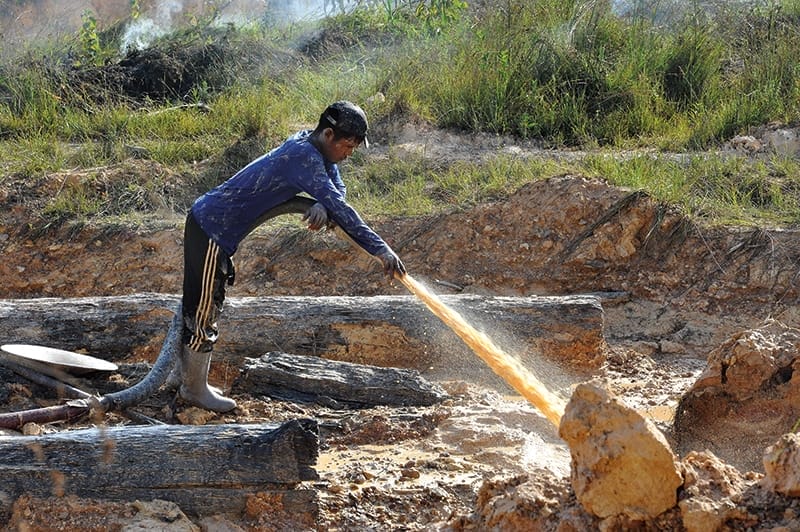
Gold nuggets, dislodged by hydraulic mining, are a commodity that’s declining in value. Photo: Susan Schulman
We land on the small airstrip in the northern town of Port Kaituma, the heart of the gold-mining territories known locally as the “backdam”. The police have a vanishingly small presence here. Violence and criminal activity – much of it associated with drugs and arms – flourish in the vacuum. Trafficked girls, sold a false prospectus by advertisements in local newspapers promising high pay for shop work in mining towns, find themselves forced into prostitution in mining camps and settlements in the area. Children as young as seven are forcibly conscripted into work in the mines.
I’ve come here with Stephanie Miguel of the Guyana Women Miners Association, an organisation of unpaid volunteers that tackles the trafficking of women and sex slavery.
Miguel is from the area. She wears rings on all her fingers and has a broad smile that proudly reveals the gold-rimmed teeth that are all the rage in Port Kaituma. Two huge gold nuggets, which she mined herself, hang from thick gold chains around her neck. A force to be reckoned with – and an ambitious entrepreneur in her own right – Miguel started mining when she was a child. “When I started panning in the mines at 11, I had no friends. I was always working around men,” she says. “It made me the strong woman I am today. I look around and know women can do things other than sex slavery. It’s about empowering women to be independent. That’s why I do this work.”
As we head out of Port Kaituma there’s nothing but bush – no shops, no towns, no houses. Our vehicle bumps heavily, endlessly, over cratered red dirt roads under the burning sun. Finally, three hours after leaving town, we turn into a narrow muddy track enveloped in bush, and arrive at Big Creek Mine.
A huge clearing stretches out to the surrounding trees. Rivulets of water snake through the pallid exposed earth to deep craters where the miners are digging for their fortunes. A man, his face rigid with determination and covered in mud, blasts the sides of his pit with a high powered jet of water, as his blue-eyed teenaged friend struggles to keep the crude pump that powers it going.
On the edge of the clearing, Evadney Abrahms is swinging in a hammock under a large tarp, pushed gently by her two small children. Abrahms works for a miner, as his cook. She is paid one pennyweight of every ounce of gold that he mines, which is worth around 10,000 Guyanese dollars (£39). “I work every day but it is still not enough to send my children to school,” she says with a sigh. “It is easier when the price of gold is better.”
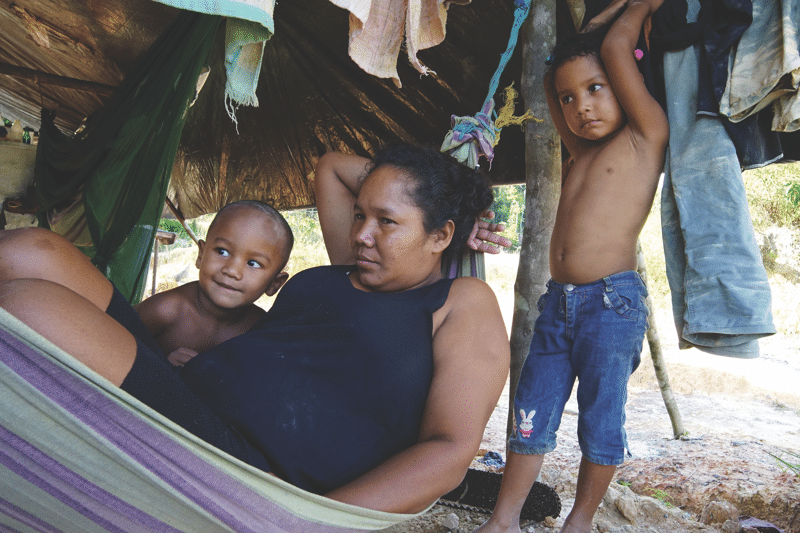
Evadney Abrahms, who works as a cook for one of the miners, with her children. Photo: Susan Schulman
No one around here thinks much about oil. Everything is about gold here, and livelihoods rise and fall on its market price.
The girls who are taken to these lawless places are at the mercy of whoever brought them there. We are deep in the forest, miles and miles from anything. Without your own transport, there would simply be no way out.
Before we left for the backdam, Miguel had introduced me to Anna, nine, who she rescued from a mining settlement just like this. With her brown hair tied back in a ponytail with a hot-pink bauble, Anna had squirmed in her chair, looking down at the floor, occasionally looking up and flashing a shy grin.
Two years ago when she was only seven, a man Anna calls “Mr Virgil” raped her. She was crumpled in a heap with her legs covered in blood when her mother found her by the creek in the Perserverance mining community where she had gone to fetch water. Anna told her mother what had happened, and at first she stopped Mr Virgil from coming to their home. But then her mother changed her mind – and sold Anna to her assaulter in exchange for food and a generator.
“I had to sleep with Mr Virgil,” Anna whispered. “He also beat me and I had to wash and clean and cook for him. Lots of others knew but no one said anything.” Her tormentor prevented her from talking to anyone and would hit her if he saw her talking to her brothers.
It’s not an unusual story in these semi-lawless territories. The US state department has classed Guyana as “a source, transit and destination country for people (including children) trafficked for the purposes of sexual exploitation and forced labour”.
Most victims go undetected in the vast backdam. Anna was lucky. “My brother saved me,” she said. On 18th September 2016, Anna’s 15-year-old brother killed Mr Virgil, strangling him with a belt, as the nine-year-old watched. The police came, arrested Anna’s brother for murder and contacted Miguel, who has taken Anna to live with her and has enrolled her in school. It was uncomfortable for Anna to tell her story. Her eyes welled up and Miguel put her arm around the child and pulled her close. “We want better for you, sweetie,” she whispered consolingly.

Stephanie Miguel of the Guyana Women Miners Association. Photo: Susan Schulman
The Anabisi Canal Bank in northern Guyana is dotted with Amerindian communities, which have been particularly hard hit by the falling gold price over the past five years.
For millennia, Guyana’s Amerindian population has hunted, fished and farmed freely on ancestral lands. But the appropriation of indigenous territory by mining concessions has left many eking out an existence in poverty on the margins of society and struggling to maintain a threatened traditional life. Some find work in the mines on land which was historically theirs: with minimal protection in place, they are easily exploited and often receive no pay for months at a time.
The bush crowds the banks and glassy waters ripple in our wake as we motor down the canal in a wooden skiff. Other boats pass by laden with passengers and sacks of vegetables: the river is the only way to access villages further down the line.
We turn in and dock. A low stepladder made from thin logs and guarded by a small dog leads to a crudely built elevated platform covered by a thatched roof. Laundry hangs over half walls, bags dangle from the ceiling and a monkey strains at its leash, giving us a quizzical glare. This is the home of Ondina Santiago, a Warraus Amerindian, and her family. As we talk, her four children scurry around merrily, barefoot and dressed only in underpants.
We grew up deep in the bush, but things are different now for my children. I am very scared for their future”
The family rely on the little money Santiago’s husband brings them from the gold mines. It is not enough. “Money isn’t coming in so I can’t buy clothes. If my children get sick, I have no money to get to the hospital,” she explains. Meat has all but disappeared from their diet in recent years. “We grew up deep in the bush – but things are different now for my children,” says Santiago. “I am very scared for their future.”
Lloyd Branthwaite, the headteacher of the nearby Canal Bank school, estimates that 40 percent of the local population doesn’t receive any formal education. “Most will end up going to the backdam to earn money,” he says, shaking his head. “It is a big problem.” Like Santiago’s children, they will never learn to read.
The government is making plans to use the future oil windfall “to the benefit of all Guyanese”, including those living in the misery of the backdam and the isolation of the rural Amerindian communities.
“We are in the process of developing a framework for use of the funds that includes generational transfers in the form of a sovereign wealth fund, budget stabilisation and infrastructural and social development,” says Minister Trotman.
Trotman claims to be on the brink of submitting an application for Guyana to join the Extractive Industries Transparency Initiative (EITI). This international body based in Norway promotes the effective and transparent use of resource revenues and sets global standards for accountability. The government hopes that membership of the EITI will allay fears that the oil bonanza will simply line the pockets of the elite rather than benefiting the whole country. It says it is determined to avoid the mistakes of other petrol powers. “The plan is not to spend wildly like a drunken sailor,” presidential spokesman Mark Archer told Associated Press in September.
In another encouraging move, on 12th October 2016 the Guyana Oil and Gas Association was launched at the Georgetown Marriott hotel. Its role is to provide a voice for the population, to push for employment opportunities and ensure transparency in the new sector. In a blow to the nascent organisation, however, two days later its president and CEO, Bobby Gossai Jr, was accused by a Guyanese national newspaper of corruption in a previous role at the gold board.
Among the fishermen repairing nets on the Georgetown dock, there is scepticism about whether oil will change the lives of ordinary people any more than gold. “Resource revenue for the past 23 years has been squandered,” says Georgell Wickham, 63, tipping back his white cowboy hat. “All of it. If it was being used properly, Guyana would be the most beautiful, wonderful country in the world.” Having fished these waters for almost 40 years, he also fears the environmental consequences if the drilling is mismanaged. “An oil spill would be a disaster for Guyana, for the fishing industry and the entire coastal plain,” he says.
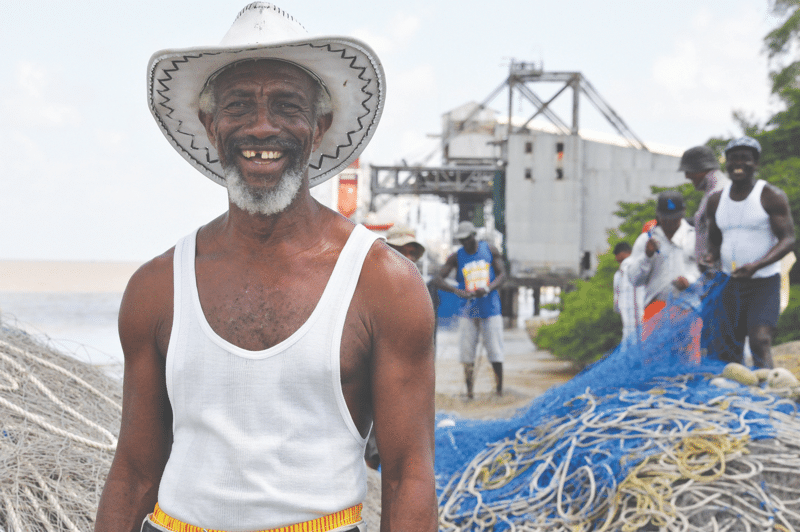
Fisherman Georgell Wickham is sceptical about oil’s benefits for ordinary people. Photo: Susan Schulman
When I push Wickham on what he’d want for the country if the money is not wasted, he lists investment in infrastructure, industry, education and jobs, as the others around us nod their agreement. “We need the investment for the country but we need to know what benefits it will bring for the children of Guyana,” says his friend Hercules Orin.
Employment is a particularly touchy subject, and one of utmost importance to the population. ExxonMobil dashed expectations of a flood of new jobs by announcing in August 2016 that only 100 roles would be created for Guyanese workers in its rigs. Part of the problem is the fact that Guyana lacks the expertise the industry needs. Although the country has been searching for oil for decades, neither training nor education in the sector has been offered until now, and the government is playing a game of catch-up.
Everywhere you travel in Guyana, the green, red and yellow of its flag – the Golden Arrow – waves gently in the tropical breeze, from dilapidated houses, shopfronts and street lamps. Despite all the hardships, nothing has diminished the abundant love and pride Guyanese have for their country.
Anand Goolsarran is anxious for his country not to follow the path of other oil states like Venezuela, which have wasted huge resources. “Corruption is the number one issue,” says Goolsarran. “Look at the oil countries which have been destroyed by oil. Oil is good and oil is bad. It could go either way.”
Some have already decided that no good will come from ExxonMobil’s discoveries. Back in Ruimveldt, Laurice raises his eyebrows when I mention the potential bonanza, as if the very idea is absurd. “No, I do not think oil will make a difference,” he says. “Not for us, anyway – for the politicians, yes.” His friend Sharon is more positive. “We Guyanese need to step up to corruption,” she stresses. “For the revenues to be used properly, it will take us Guyanese getting out in the street. And we will. It is the future of our kids.”
Alongside all the concerns and scepticism, many hope Guyana’s fortunes could be transformed by the vast oil reserves lying off the coast. It would be a future worth fighting for, says Juliane Persaud, who works in the Georgetown office of the World Wildlife Fund.
“If no best practices are implemented and there is no effective revenue sharing… It could leave the country in the same or even worse condition,” she says. “It would be a huge injustice.” But, she adds, “If it’s done right, then there’s a real opportunity for the country. It could be a win-win.”
Slow Journalism in your inbox, plus infographics, offers and more: sign up for the free DG newsletter. Sign me up
Thanks for signing up.
